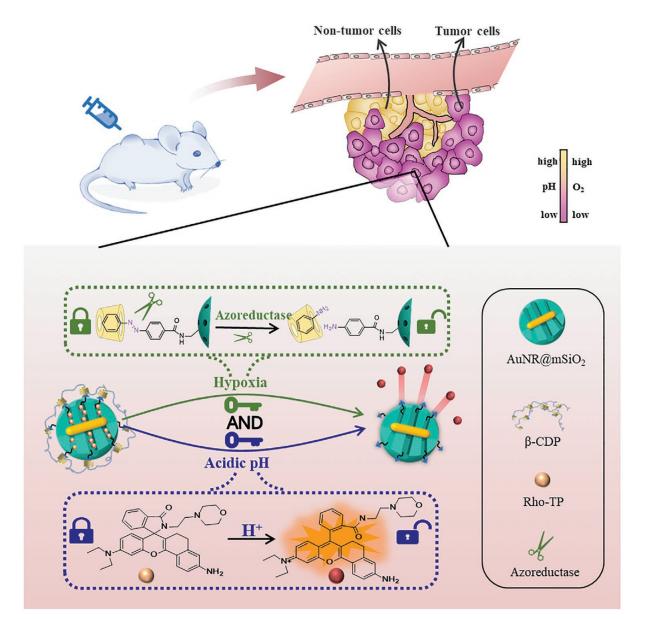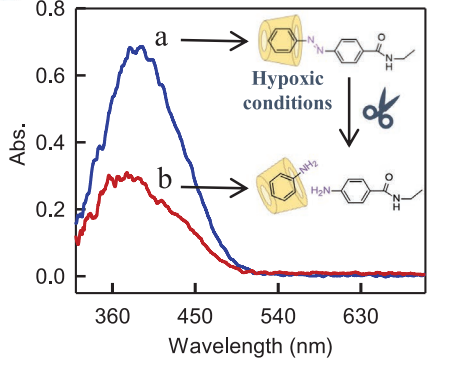文献:Design and Engineering of Hypoxia and Acidic pH Dual-Stimuli-Responsive Intelligent Fluorescent Nanoprobe for Precise Tumor Imaging
文献链接:https://onlinelibrary.wiley.com/doi/abs/10.1002/smll.202100243
作者:Shiya Chen, Mingjian Chen, Jinfeng Yang, Xianqing Zeng, Yibo Zhou, Sheng Yang,Ronghua Yang, Quan Yuan, and Jing Zheng
相关产品:Cy5 花菁染料CY5
原文摘要:
Stimulus-responsive fluorescence imaging modality shows great promise for detection of tumor due to the advantages of high sensitivity, simplicity and noninvasiveness. However, some non-cancer regions including nodules and inflammation may also exhibit a stimulus-related characteristic, which cause the problem of nonspecific responsiveness and then cause “false positive” results for tumor recognition. Herein, hypoxia and acidic pH, two typical features strongly associated with tumor invasion, progression and metastasis in tumor microenvironment (TME), are chosen as dual stimuli to fabricate “dual lock-and-key” fluorescent nanoprobe for highly specific and precise imaging of tumor cells. Mesoporous silica coated gold nanorods (AuNR@mSiO2) are employed as nanocarrier and nanoquencher to load the pH-sensitive fluorescent reporter (Rho-TP). Azobenzene (azo) which can be reduced to amines by the highly expressed azoreductase under hypoxic conditions, is elected as the effective gatekeeper for AuNR@mSiO2 by forming complex with β-cyclodextrin polymer via host-guest interaction (azo/β-CDP). By elaborately combining the hypoxia-responsive gatekeeper and pH-responsive fluorescent signal reporter into one nanoprobe, sensitive and specific imaging of tumor cells can be realized. The fabricated dual lock-and-key fluorescent nanoprobe successfully further apply in tumor-bearing mice model, which indicate potential of early diagnosis and assessment of cancer treatment.
该文献研究的方向是介孔二氧化硅涂层金纳米棒(AuNR@mSiO2)用作纳米载体和纳米猝灭剂,以负载pH敏感荧光报告子(Rho-TP)。由于CY5具有良好的光稳定性和化学稳定性,可以在长时间的照射下保持其荧光性质。然而,Cy5对氧和pH敏感,因此需要在无氧和中性pH环境下使用和保存。客户使用我们瑞禧的产品花菁染料CY5做了相关对照,内容如下:

图为:缺氧和酸性pH双刺激响应智能荧光纳米探针
β-CDP用作构建AuNRs@mSiO2:
先研究了4-(苯偶氮)苯甲酸的还原性能酸在偶氮还原酶的作用下。用偶氮还原酶Treatment 后偶氮的H信号消失,而特征H信号消失4-氨基苯甲酸上出现了-NH2。随后检查偶氮/β-CDP对偶氮还原酶的反应性能复杂。由图片可以看出4-氨基苯甲酸明显减少在添加偶氮还原酶后。基于此,β-CDP然后将其功能化到AuNRs@mSiO2via主客体相互作用作为缺氧感知元件的开关。AuNR上明显的二氧化硅外壳涂层从TEM图像中观察到,证实了HADFN的成功建设。与此同时,Cy5以相同的方式加载到纳米粒子中以构建对照HADFN对缺氧条件的反应与HADFN相似,但pH不敏感(命名为作为HFN)

图为:azo/β-CDP复合物溶液(5µm,10%乙醇,pH 8.0)在a)常氧和b)缺氧条件下的吸收光谱。
结论:该文献使用同种方法利用β-CDP用作构建AuNRs@mSiO2和CY5标记加载到纳米粒子中以构建对照HADFN,可以得到cy5负载HFN在常氧条件下的荧光信号较弱(pH 6.0和8.0),而在缺氧条件下(pH 6.0和8.0)均增加,表明HFN对缺氧敏感,而对pH无反应。HADFN对其他物种的缺氧响应性偶氮还原酶和H+具有良好的选择性。

 2024-11-18 作者:wff 来源:https://onlinelibrary.wiley.com/doi/abs/10.1002/smll.202100243
2024-11-18 作者:wff 来源:https://onlinelibrary.wiley.com/doi/abs/10.1002/smll.202100243

